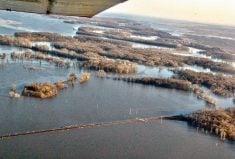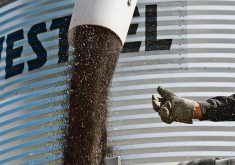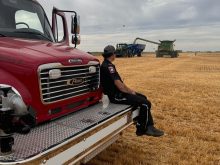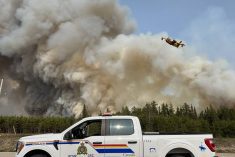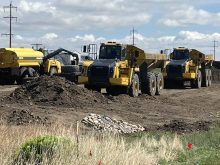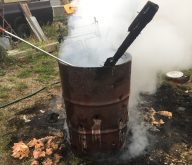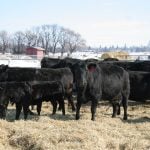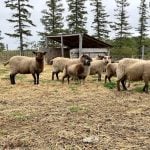Agricultural production is one of the most dangerous occupations. On average, more than 100 people are killed and thousands injured in Canada annually in farm and ranch accidents. Despite years of farm safety campaigns, reducing these statistics is a painfully slow process. The Western Producer’s Mary MacArthur explores how farm safety experts are shifting education toward children to get results.
VEGREVILLE, Alta. — Extra safety measures can be found throughout the buildings, shops and feedlots at Highland Feeders.
The animal health building has an eye wash station, first aid kit and fire extinguisher. Beside the shelf of drugs is a binder with a material safety data sheet on each veterinary drug used in the feedlot.
Read Also

VIDEO: Agritechnica Day 4: Robots and more robots, Nexat loves Canada and the trouble with tariffs
Agritechnica Day 4: Robots and more robots, Nexat loves Canada and the trouble with tariffs.
The feed mill has fire extinguishers on every wall.
The safety features are the work of volunteer safety consultant Eric Jones, the former Alberta Agriculture farm safety co-ordinator.
By working at Highland Feeders two days a week, he hopes to build a sensible farm safety template that can be copied by other feedlots and hopefully reduce farm accidents.
While Highland Feeders has a good safety record and Jones has the support of owners Bern and Mike Kotelko, it is a challenge to work with staff not interested in hearing his safety lessons.
In the feedlot, it’s pen riders who often offer the most resistance.
“It’s a culture,” said Jones, referring to the independent spirit of horse owners who believe accidents won’t happen to them.
Of 23 farm deaths in Alberta in 2008, two were caused by horses. Of 757 farm-related injuries during the same period, 95 were horse related. The injury list is not complete. It is not mandatory for hospitals in the province to report farm injuries.
Jones is continually looking for new ways to improve worker safety in an occupation slow to make it a priority.
“They’re so busy running their business that safety is just one of the issues and is not as high on their agenda as making a living.”
Jones walks each new employee at Highland Feeders through their work place, pointing out possible dangers, safety equipment and first aid kits.
“They have to show me they know how to use (the kits),” said Jones.
To track staff training and encourage work place safety, he issues a Work Safe passport, a pocket-sized booklet where health and safety training is recorded. If workers move to other farms or feedlots, Jones hopes they’ll take their passport and continue their farm safety training.
His training has no paperwork or tests, just practical information of possible hazards and how to use safety equipment.
Jones believes all farms and feedlots should hold a hazards assessment check before large, busy operations like the fall calf run, in which thousands of cattle come onto the lot, or the harvest or seeding seasons.
“It makes you stop and take a moment to think about what you’re doing,” he said, adding that it costs little to hold tailgate meetings that allow workers to analyze hazards they may encounter that day.
“An assessment is just giving them time to reflect and nobody has done that before. It keeps them aware because in safety, attitude is everything.”
Bern Kotelko said worker safety is a high priority, but there are limits on what a farm can spend on safety.
“Safety is important. That’s why we’re doing it on our own, but we can’t pass the costs on,” he said.
In Alberta, farms are exempt from the Occupational Health and Safety Act that regulates workplace safety. Under the act, workplace hazard assessment is mandatory for larger projects on non-farm jobs.
Through his safety-focused eyes, Jones sees potential danger where others don’t.
James Peat of Two Hills, Alta., a six-year employee at Highland Feeders, said Jones is a good safety mentor.
“Sometimes it helps to have an outsider,” said Peat, who credits Jones for improved lighting and getting more fire extinguishers in the feed mill.
“He’s certainly made us realize to be a lot more observant.”
Jones was also hired by Tongue Creek Feeders owner Peter Morrison of High River, Alta., after a worker was killed cleaning crusted grain from the inside walls of a giant silo.
During the judicial inquiry into Kevan Chandler’s death in 2006, Jones recommended an expert farmer committee be established to implement and enforce farm safety standards.
The safety committee would operate similar to British Columbia’s Farm and Ranch Safety and Health Association, a voluntary but co-ordinated approach to farm safety education, training and farm workers rights. If a committee is run by farmers, Jones believes they’ll be more likely to buy into the process.
“We need it to be run by farmers to make it palatable. If they did it themselves, they wouldn’t be against it as much.”
It’s also what Wild Rose Agricultural Producers recommended recently when the province asked for suggestions on ways to improve farm safety.
In the fatality report prompted by Chandler’s death, justice Peter Barley recommended training programs be established for farm workers and that paid employees be covered by the Occupational Health and Safety Act.
Barley’s recommendations prompted the call to farm groups for ways to improve farm safety, said Laurel Aitken, farm safety co-ordinator with Alberta Agriculture.
The government is not just looking at possible changes to legislation, but to education, said Aitken, one of three part time staff working in Alberta’s farm safety branch delivering farm safety information to 50,000 farmers. Occupational Health and Safety has 84 inspectors for the 140,000 non-farm businesses in the province.
Policing every farm to ensure safety procedures are followed wouldn’t be possible or logical, said Jones. But making sure every farm fatality is investigated and recommendations published about how the situation could be prevented would help to heighten safety awareness.


